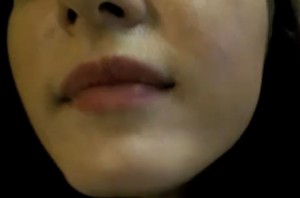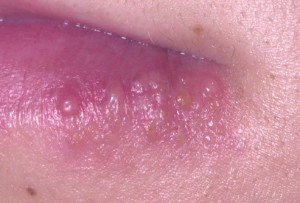Fever blisters on lips, is a condition that results in the development of fluid-filled lesions that is caused due to infection by the herpes simplex virus type 1. Fever blisters are often referred to as cold sores.
Individuals who have been affected by fever blisters on lips can easily sense the beginning of a new case of the condition, by symptomatic tingling sensation on the lips. After a few days the red colored fever blisters erupt on the lips and there are no ways to quickly treat them or hide them
Fever blisters on the lips are often associated with canker sores, but the two conditions are different from each other. Even though it is not possible to prevent or cure instances of fever blisters on lips, one can take the necessary steps to limit their duration as well as reduce their frequency.
Symptoms of fever blisters on lips
Some of the signs and symptoms of fever blisters on lips are listed below:
- The fever blisters or sores generally tend to appear within a week after exposure to the herpes simplex virus. On occasions the signs and symptoms of fever blisters on lips may not commence for as long as three weeks after exposure.
- Fever blisters on the lips develop, break and then ooze. After that, a yellow crust develops and then it breaks off to show light pink colored skin that heals without leaving a scar mark.
- The formation of fluid-filled, tiny and painful blisters on an elevated region of the skin which is typically around the oral area and most often on the lips
- The condition generally tends to last for ten to fourteen days
- The fever blisters on lips may be preceded by feelings of tingling or pain known as prodrome, one or two days prior to the development of the condition
- Fever blisters most often occur on the lips. Sometimes, they appear on the fingers, chin or on the nostrils. On rare occasions, the fever blisters may appear inside the mouth, on the roof of the oral cavity or the gums. The sores that occur on other soft tissues of the oral cavity, such as below the tongue or the insides of the cheeks generally tend to be canker sores than fever blisters.
- A complication of fever blisters on lips is the spread of the infection to the eyes. Infection with the herpes simplex virus can cause scarring of the cornea and most often leads to blindness.
Causes of fever blisters lips
- Fever blisters on lips are caused by certain strains of the herpes virus. Most often cold sores are caused by the herpes simplex virus type. The herpes simplex virus type 2 causes the development of genital herpes. However, either one of the herpes strains of viruses may be responsible for the formation of fever blisters on lips.
- Contact with another person individual who has an active lesion may result in the development of the first episode of fever blisters on lips. The sharing of personal items such as razors, eating utensils, towels, etc. as well as acts of kissing may aid the spread of herpes simplex virus 1. Also, any form of oral-genital contact with an affected individual may result in the development of herpes simplex virus type 1 infection of the genitals.
- After the initial exposure to the herpes virus, it tends to remain dormant beneath the skin in the nerve cells and tends to materialize into an active infection once again at or near the site of the original infection.
- Individuals may have sensations of heightened sensitivity or itchiness at the affected region before every attack. A relapse of the infection is usually triggered by fatigue, menstruation, fever, stress or increased exposure to the sun.
- Canker sores which are usually associated with fever blisters on lips are not contagious. However, cold sores are highly contagious and pass on from one individual to another by skin-to-skin contact. Other individuals are at greatest risk to contact fever blisters on lips from affected people, from the time they appear till the time they have crusted and completely dried. However, the infection may still spread for some time, even after the cold sores have healed.
- Individuals with skin diseases such as atopic dermatitis or with immune system disorders such as cancer, etc are at a greater risk to contact the condition from affected individuals and hence should avoid any contact with them.
Fever blisters on lips treatment
- Fever blisters on lips generally tend to resolve on their own without any treatment, in about two weeks. There are several topical drugs that can be sued to alleviate the symptoms of the condition. Some of them are listed below:
- Benzocaine can be used to protect the fever blisters on lips from irritation and injury. However, the medication has some side effects and should be used only after consultation with a doctor.
- Lidocaine can be used to provide temporary relief from pain.
- One may consume oral antiviral drugs such as acyclovir, valacyclovir, etc., to alleviate the pain and decrease the duration of fever blisters on lips. Such drugs may also be prescribed by doctors to prevent frequent relapses of the condition.
- Additionally, one should avoid pricking or pinching the blisters, avoid exposure to sun and other triggers, use a sunscreen while outdoors and also avoid contact with other individuals to prevent the spread of the condition.
Fever blisters pictures


Together with everything which seems to be building inside this particular area, your viewpoints are actually fairly exciting. Nonetheless, I am sorry, but I can not subscribe to your entire plan, all be it radical none the less. It appears to everybody that your opinions are generally not completely justified and in simple fact you are yourself not thoroughly confident of the assertion. In any event I did appreciate reading it.